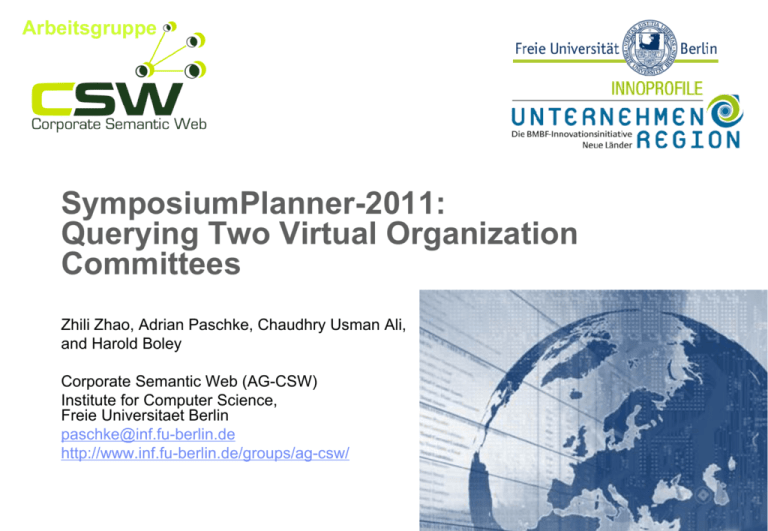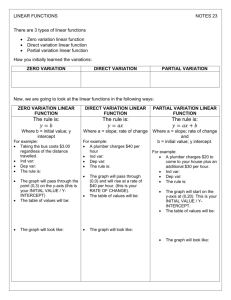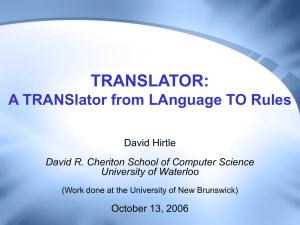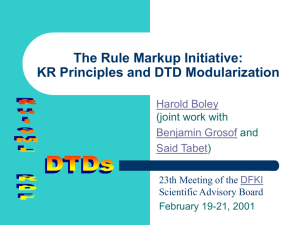SymposiumPlanner-2011
advertisement

Arbeitsgruppe
SymposiumPlanner-2011:
Querying Two Virtual Organization
Committees
Zhili Zhao, Adrian Paschke, Chaudhry Usman Ali,
and Harold Boley
Corporate Semantic Web (AG-CSW)
Institute for Computer Science,
Freie Universitaet Berlin
paschke@inf.fu-berlin.de
http://www.inf.fu-berlin.de/groups/ag-csw/
What is SymposiumPlanner?
Is a series of Rule Responder instantiations
for the Q&A sections of the official websites of
the RuleML Symposia since 2007
Organizational Agent (OA) filters and delegates
of incoming queries
External Agent (EA) acts as the interface to the
organizational agent, i.e. as the single point of
entry to support the symposium organization
Personal Agents (PAs) assist symposium chairs
Organizational Agents
Represents goals and strategies shared by
each member of the Symposium
organization
Contains rule sets that describe
the policies, regulations, opportunities, and
expertise of its organization
Manages the roles of each personal agent via
a Role Assignment Matrix
Personal Agents
Act in a rule-based manner on behalf of
symposium chairs
Work on a profile of FOAF-like facts and
FOAF-extending rules that encode ‘routine’
knowledge of symposium chairs
Role Assignment Ontology
Topics
Personal Agents
Metatopics
General Chair
General Chair
Program Chair
Program Chair
Challenge Chair
..
..
..
Challenge Chair
..
..
.
Publicity Chair
Publicity Chair
Liaison Chair
Liaison Chair
Properties:
Responsible
Accountable
Sponsoring
..
.
Press Release
Challenge
..
.
Demos
Media Partners
..
.
Sponsors
Registration
..
.
Visa Letter
Submissions
.
SymposiumPlanner 2011 Architecture
One super-OA:
OA@SymposiumPlanner2011
Two sub-OAs:
OA@IJCAI 2011 and
OA@BRF 2011
Each agent consists of
internal or external
knowledge sources.
Reaction RuleML
messages are transported
via the ESB to the
appropriate agent with
different transport
protocols
Communication Middleware
Mule Enterprise Service Bus (ESB)
Is used to create communication
end points at each Personal and Organizational
Agent
Provides a highly scalable and flexible application
messaging framework to communicate
synchronously or asynchronously
Supports a variety of transport protocols
(including HTTP, JMS, JDBC, SOAP, etc.)
Is based on a staged event-driven architecture
(SEDA)
Rule Engine: Prova
Is both a rule language and a rule engine
Tight integration of Java and Semantic Web
technologies
Is used to realize the organizational agents of
SymposiumPlanner system
Prova: Messaging Reaction Rules
Send a message
sendMsg(XID,Protocol,Agent,Performative,[Predicate|Args]|Context)
Receive a message
rcvMsg(XID,Protocol,Agent,Performative,[Predicate|Args]|Context)
Receive multiple messages
rcvMult(XID,Protocol,Agent,Performative,[Predicate|Args]|Context)
XID is the conversation identifier
Protocol: protocol e.g. self, jms, esb etc.
Agent: denotes the target or sender of the message
Performative: pragmatic context, e.g. FIPA Agent Communication
[Predicate|Args] or Predicate(Arg1,..,Argn): Message payload
Example
getTracks(XID,Track):% look-up responsible agent (Program Chair) from RAM
assigned(XID,Agent,ruleml2011ATijcai_ProgramChair,ruleml20
11ATijcai_responsible),
% send the query to personal agent
sendMsg(XID,esb,Agent, "query", getTrack(Track)),
% receive answers multiple times
rcvMult(XID,esb,Agent, "answer", substitutions(Track)).
Access to External Data Sources
(Prova query built-ins)
File Input / Output
..., fopen(File,Reader), ...
XML (DOM)
document(DomTree,DocumentReader) :- XML(DocumenReader),...
SQL
... ,sql_select(DB,cla,[pdb_id,"1alx"],[px,Domain]).
RDF
...,rdf(http://...,"rdfs",Subject,"rdf_type","gene1_Gene"),...
XQuery
..., XQuery = 'for $name in StatisticsURL//Author[0]/@name/text()
return $name', xquery_select(XQuery,name(ExpertName)),...
SPARQL
...,sparql_select(SparqlQuery,...
Reaction RuleML
Is a branch of the RuleML family that
supports actions and events
Works as interchange language between
agents, where Reaction RuleML messages
are sent through the ESB
The ESB carries RuleML queries
(requests), answers (results), and rule
bases to/from agents
Example Reaction RuleML Message
<RuleML xmlns="http://www.ruleml.org/0.91/xsd"
xmlns:xsi="http://www.w3.org/2001/XMLSchema-instance"
xsi:schemaLocation="http://www.ruleml.org/0.91/xsd
http://ibis.in.tum.de/research/ReactionRuleML/0.2/rr.xsd"
xmlns:ruleml2011="http://ibis.in.tum.de/projects/paw#">
<Message mode="outbound" directive="query-sync" >
<oid> <Ind> RuleML-2011-IJCAI </Ind> </oid>
<protocol> <Ind>esb</Ind> </protocol>
<sender> <Ind>User</Ind> </sender>
<content>
<Atom>
<Rel>getContact</Rel>
<Ind> ruleml2011ATijcai_GeneralChair </Ind>
<Var>Contact</Var>
</Atom>
</content>
</Message>
</RuleML>
User Clients
Ways of issuing queries:
Follow a menu to create and fill
HTML forms
Or use Attempto Controlled English
(a rich subset of standard English
designed to serve as knowledge
representation language)
*Attempto Project: http://attempto.ifi.uzh.ch/site/
Queries Defined by Organizational Agent Interfaces
Describe public interfaces of
rule functions with an XML file
Translate interfaces
descriptions to HTML forms
Construct Reaction RuleML
queries with interface
descriptions and parameter
values
Issue Query with Attempto Controlled English
ACE Text
Attempto Parsing
Engine (APE)
Example:
"Who are the
authors of 'Rulebased Distributed
and Agent
Systems'"?
Discourse Representation
Structure (DRS)
XML Parser
<DRS domain="">
<Question>
<DRS domain="A B C">
<query obj="A" question="who" sentid="1"
tokid="1"/>
<relation obj1="C" rel="of" obj2="string('Rulebased Distributed and Agent Systems')"
sentid="1" tokid="5"/>
<object ref="C" noun="author" struct="countable"
unit="na" numrel="geq" num="2"
sentid="1" tokid="4"/>
<predicate ref="B" verb="be" subj="A" obj="C"
sentid="1" tokid="2"/>
</DRS>
</Question>
</DRS>
Reaction RuleML
Message
<Atom>
<Rel>getAuthorsOfPaper</Rel>
<Ind>'Rule-based Distributed
and Agent Systems'</Ind>
<Var>author</Var>
</Atom>
Example Rule Function Interface Description
<signature agent="SymposiumPlannerSystem">
<meta>
<Atom>
<Rel iri="dc:description"/>
<Data xsi:type="xs:string">decide whether can submit a paper</Data>
</Atom>
</meta>
<qualification>
<Atom><Rel iri="http://reaction.ruleml.org/ns/signature/Public-Signature"/></Atom>
</qualification>
<oid><Ind>submission</Ind></oid>
<Expr>
<Fun mode="+" meta="User's Contact Informaion">contact</Fun>
<Var mode="+" meta="User's FirstName" default="Mark">FirstName</Var>
<Var mode="+" meta="User's LastName" default="JBoss">LastName</Var>
<Var mode="+" meta="User's Country" default="USA">Country</Var>
<Var mode="+" meta="User's Email" default="markDOTjbossATgmailDOTcom">Email</Var>
</Expr>
<Var mode="+" type="string" meta="Paper Title" default="Rules and Automated Reasoning">Title</Var>
<Var mode="+" type="string" meta="Paper Type" default="Full Paper" candiates="Demo Paper;Full
Paper">SubmissionCategory</Var>
<Var mode="+" type="string" meta="Paper Keywords, please serparated by semicolon." default="rules;
reasoning">Keywords</Var>
</signature>
Online Demo
Online Demo
http://de.dbpedia.org/redirects/ruleml/ACE2
ReactionRuleML/
Analysis
SEDA decomposes the processes of Q&A in
SymposiumPlanner with event-driven stages
connected by explicit queues
SEDA maximizes throughput and exhibits higher
performance and more robust behavior under
load than traditional service designs
SymposiumPlanner can process users' queries
reasonably and prevent resources from being
overcommitted when demand exceeds agent
processing capacity
Conclusion
Adapted to organize the both installments
of RuleML 2011 Symposium
Created three OAs to bring clarity in system
operations
Access to external data sources (e.g. Semantic
Web DogFood, FOAF profiles) and ontologies
(responsibility assignment matrix ontology) from
the rule-based agents
Provides a more powerful user Client
Template-based Configurable Web Forms
Attempto Controlled English (translation into
Reaction RuleML)
Questions?









